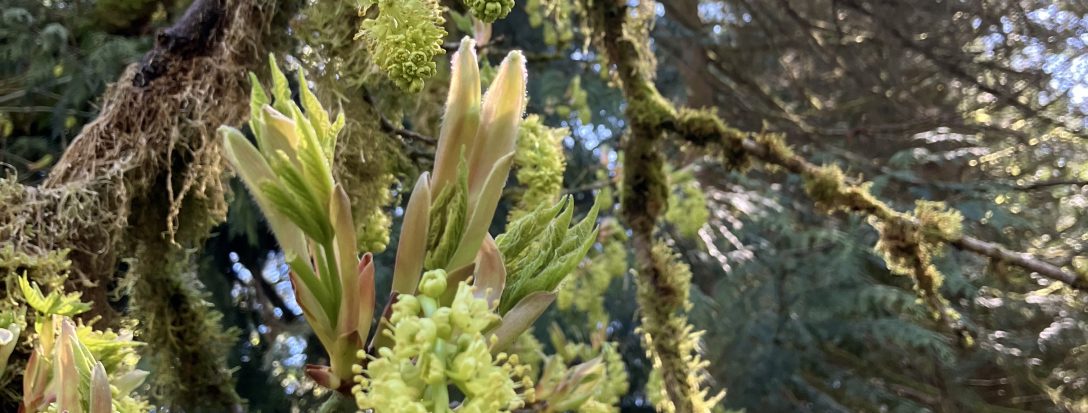
Here at EEC Forest Stewardship, we’ve been establishing hedges around the landscape to offer focused transition spaces between the open pastures, and established evergreen dominate forests. These edge spaces are great habitat for species that need the shelter of a forest, yet require more light pouring in from the cleared field. Our native shrubs like hazel are perfect hedge varieties, but work well with other vegetation mixed in so we planted big leaf maple as an experiment. Usually the maples would quickly sprout up over the tops of the young hazel, but we’re pleachering the maple (laying it sideways), along with the hazel to form a horizontal barrier along the forest edge. The planting pictures above was established about five years ago, and it due now for a second layering. Hazel is one of the first species to put out catkins in preparation for spring pollination- and the sexual organs are already hanging from the woody branches with buds bulging from wispy twigs.
Establishing hedgerows takes time, and EEC has been planting and setting these masterful natural fences across the property where they will best suit long term restoration goals. The spot photographed above and below in this article runs along a keyline across a slight slope. This hedge space will catch and slow surface water, as well as hold the soil and prevent erosion. Eventually, the oaks will dominate this spot of land (they are flagged in orange in the picture below). It might be hard to see the organized chaos, but there is a line of hedge planting comprised of hazel and maple, and the oaks are offset about 10 feet from the hedge. Eventually, this whole area will be shaded back in by the larger, more established evergreen forest surrounding this clearing, but perhaps, the oaks will get high enough into the canopy to compete for light. Hazel can survive in the under-story, and the big leaf maple will eventually turn upward and race for the sky.

Evolving edge space into dense, diverse habitat involves planting and replanting to maintain a desired line. Hazel is a natural stool and suckering propagator, so layering the branches over using pleachering, then partially reburying those branches back into the ground, speeds up the establishment of the hedge line. I’ve been experimenting with big leaf maple trees using this method and they are re-rooting in much the same way, with less suckering. I’m eager to extend this style of hedge layering hard wood trees to include other nut verities like chestnut and walnut too. Another great hedge species that’s a prolific is red flowering current. I’ve got a shrub up by the kitchen garden that I regularly re-pot branches from to make new plants. By potting the branches, I keep track of the new plants and can easily cut the main branch to separate the potted shrub from the main bush. The potted branch takes about two seasons to re-root.




Protecting young plantings can be another challenge. Deer, livestock, and people can damage a newly set hedge if not properly fenced off. In the picture above, a neighbor friend has used her round-pen to keep horses and deer out of her nut grove, which also holds a verity of hedge plants around the circumference as a future natural barrier. These young plantings have taken a few years to establish, and you’ll want to figure that into your fence design- the protection will have to hold up for at least three years to protect young plants. If fencing is not your bag, over plant the hedge by 4x the amount of vegetation you’d like to see established and hope for the best. I had great success with this using willow. The faster your plants grow, the sooner your hedge will set.
Here in Western Washington, the abundant rain and mild temperatures invite quick growth in many species- especially hedge row verities. Hazel, maple, and currants are tried and true, and you can mix in some slower growers like oak, though tree verities will become standards which can out compete your hedge in the long run. Oak is not usually a hedge tree, as the tannin from the leaves prevent many other plants from successfully germinating in the soil at the base of the tree. Hemlocks will do that too, and cedar, not all plants play nice together, and when you are working to plant cooperative species in a hedge you want everyone to get along in the sandbox- so to speak.
Above is a pastoral scene at EEC with our Katahdins grazing peacefully with this year’s lambs prancing about. Behind them is our property boundary lined with a high fence to the left, and a well established blackberry hedge to the right. The sheep are not interested in testing that boundary. A person could walk through the blackberry on right, and a sheep might if left on stressed pasture and in need of fresh fodder. But at this time of year, in mid-winter, our pastures are still green, in part thanks to good rotational management of the ground. The slight slope is interrupted by swales along this hillside. That’s the trench you see the lambs bouncing down and back up out of below the ewes. There is also some great leaf litter mulch from the forest of red alder just beyond the hedge and fence. We’re looking east in this video. The fence line runs north/south, allowing good light to reach all the vegetation. If the forest was south of the fence line, the hedge would not get any light, and you’d need to put in a fence instead of a living wall. If you plant a hedge with a young forest to the south, you’ll have a hedge for a while, but eventually, the forest will create a dominate canopy and shade out the understory.
The example above has hedge and fence mixed together, which is a good way to manage gates and drives near a hedge. Hedges near drives and paths should be set back from the throughways to prevent overgrowth clogging the flow of movement. Hedges get bigger as they age, and like to move outwards as well as upwards, so have a good 16′ setback from roads and drives if you can. The fence line above is planted with fruit trees and hedge species along the inside of the hard wire, and that fence will eventually continue all the way along the property line. For now, the blackberry fills the gap nicely, and our stock stays in the field where we want it to. Bramble makes a good hedge, and here, our sheep brows the growth to keep it back from the field, though you might spot a few rouge plants straying into the grasslands. We do still have to use a scythe from time too time to keep the field open. In time, our fruit and nut trees in this area will create canopy to shade out the bramble.

The oldest and most well established hedge at EEC is along our north property line. It’s the towering green wall on right in the dawn light picture above. This hedge is comprised of holly, alder, cherry, and a standard western hemlock. There’s a gaping hole under the hemlock where the shrubs do not grow, so I put all the holly cuttings in that area to form a dead hedge which closes the gap and completed the wall. This hedge is over two stories tall in some places, as it’s never been layered like a traditional hedge. It’s also on my neighbors property, so other than trimming it back off the drive, II have little influence over it’s growth. It’s important to think about how your hedge might impose on neighboring properties- you might not want to select invasive species like holly if you know you neighbor will end up having to defend against its invasion, but this hedge popped up naturally after a fence line was put in. Birds sat along the fence and pooped out the seeds of everything growing there today. The same happens under power lines- take a look next time and see if there’s a hedge under your nearby power-lines. Unless mowed, the spaces that host birds will one day host vast hedgerows.
Hazel, maple, and oaks are also my focus species for future planting here at EEC, because they seem to adapt to the changing climate more readily than many of the evergreen species. I’ve stopped planting hemlock all together, as the established trees on the landscape are starting to die. Drought and relentless summer heat have taken their toll on our temperate rain forests, and after ten years of close observation, the most denigrated species on our land is western hemlock. We’re also not planting many red cedars, who are also very water dependent. Oak are the replacement we’re choosing, though they might still be out competed in the long run by Douglas firs. We’re hoping the deciduous species will offer a little more winter light, while creating mulch with fall shedding and diversity within out future forest. Because people are still living on this land, beneficial species that produce more immediate food sources are relevant to our planning. I love the vision of one day harvesting acorns on this landscape, along with hazel nuts, chestnuts, and endless fruit verities. Yes, you can set your hedge with fruit trees if you like, though your livestock might get most of it.
EEC will continue to slowly bring in the edges, closing up older pastures with new forest while maintaining a diversity of plants which offer food, medicine, material, and resiliency for us and the forest. These transition spaces host abundant wildlife, habitat, and biomass across the landscape for all to enjoy. The other key element to a good transition zone is pollinator species. Fruit and nut trees all need pollination, but ground level flowers are also important. Make sure there’s a good wildflower mix at the foot of every hedge. Foxglove, trailing blackberry, dandelion, and evening primrose are some of my favorites. I sew different wildflower mixes every year- though much of it is lost to the chickens and wild birds who glean the seed. Still, it’s worth broadcasting seed when you can, and it will tell you what the soil condition is by what comes up. You can use your hedge plantings to further condition the soil over time. Plant plant plant, then watch it grow.

